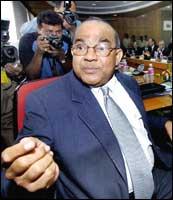 Reserve Bank of India Governor YV Reddy deftly evades a question on whether the RBI has changed its monetary policy position from neutral to hard, but admits that the interest rate cycle has changed. He also feels that the bank rate is the real signalling device and not the repo rate.
Reserve Bank of India Governor YV Reddy deftly evades a question on whether the RBI has changed its monetary policy position from neutral to hard, but admits that the interest rate cycle has changed. He also feels that the bank rate is the real signalling device and not the repo rate.
In a free-wheeling interview with Business Standard, the RBI governor says he believes that too much credit is chasing the housing industry and warns of the possibility of an asset bubble.
On the controversial issue of using foreign exchange reserves for infrastructure development, Reddy says International Monetary Fund guidelines on using reserves do not come in the way of this -- it is indeed possible to use the reserves provided it is done in a transparent manner, fulfilling other relevant conditions.
Excerpts:
On the government's plan to use the RBI's foreign exchange reserves for infrastructure development. IMF rules do not permit this.
Let's not confuse the main issue. The moment part of the reserves is used for some other purpose, it no longer remains (part of) reserves. Whether the use of reserves has an IMF restriction is irrelevant.
At a purely operational level, reserves can be used for any purpose.
But it should be consistent with macroeconomic stability and the RBI's balance sheet requirements. Besides, the policy of using reserves should be transparent.
Within these parameters, reserves can be used for commercial purposes.
On whether the main purpose of the repo rate increase was to manage expectations.
Yes, it is about managing expectations. There is always a bit of alignment, a bit of leading and a bit of following the financial market. By and large, when the market interest rate is moving in one direction, the policy objectives cannot move in the opposite direction.
If the objective conditions require a signal, it is far better to do that.
On why the bank rate was not changed.
The bank rate is basically a signal rate. But if you see in the past, the number of times the repo rate changed has always been more than the number of times the bank rate changed. Also, in the initial two to three years, changes in the bank rate were made more frequently to actually make it relevant -- the rate was about 12 per cent or so.
But what does the bank rate imply? It is the rate at which I provide liquidity. But at the moment, where there is excess liquidity; the rate at which I take in liquidity is a lot more relevant.
On whether this is the end of the low interest rate regime.
In November 2003, we had mentioned that there is an interest rate cycle, but it is very difficult to pinpoint where we are in the cycle. So it is better for market participants to prepare for an uncertain situation.
At the moment though, globally there is a movement from an easy to a more neutral stance. There is a relationship between how interest rates are moving globally and how domestic rates have to move.
On whether the RBI's change in stance is from easy to neutral or hard.
I seldom use words like easy and neutral because our situation is complex. There are market rates, small savings rates, and the rates are different in the credit markets. With the type of liquidity we are managing, it is difficult to put a label.
On whether the RBI wants to shift the growth of credit from the retail sector to SMEs and agriculture.
The limited point is that credit is growing. But once it is growing very fast we have to look at its quality. The overall quantity growth (in bank credit till October) is good, given the low base of last year, but we would not like it to grow too much faster.
Usually, in the first half the (incremental non-food credit-deposit) growth is 30-40 per cent, but this time it has been much more. So it could accelerate quite significantly in the second half.
There are two ways to control this. Either you make it expensive or give a signal that there are some areas that you do not want credit to grow that fast and there are other areas where you would not be unhappy with the growth.
In some of the Asian countries where they already have too much retail lending, they have burnt their fingers. In the housing sector, given the high penetration, there is too much credit chasing the same real economic activity; it is reflected as an appreciation in asset values.
At some stage it could lead to an asset bubble. We have no evidence of any of this, but there is a sense of discomfort even among some bankers about this type of growth.
On whether real interest rates for depositors (with the RBI raising the inflation rate estimate to 6-6.5 per cent) are negative.
How do I calculate the real interest rate -- should it be on the basis of WPI, CPI or some other average? It is not easy to calculate the real interest rate.
Over a medium term one has to be conscious of the need to maintain a reasonable return. This is something the finance minister has mentioned in the Budget.
There are assured-return schemes outside the banking system, including small savings. People can put in money there to earn a higher return.





